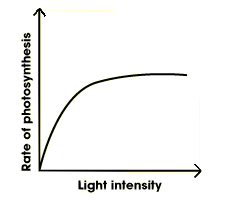Plants in Ecosystems
Photosynthesis
Photosynthesis is the fundamental process by which plants manufacture food molecules (carbohydrates) from raw materials (carbon dioxide and water) using energy from light.

In other words...
In photosynthesis, plants absorb light energy from sunlight and use that energy to convert carbon dioxide and water into glucose as stored chemical energy and oxygen.
This stored chemical energy can then be broken down by the plant and used for life processes such as:
- Growth
- Reproduction
The word equation for photosynthesis is:
carbon dioxide + water --> glucose + oxygen
The chemical equation for photosynthesis is:
Photosynthesis has 4 requirements:
- carbon dioxide
- water
- light
- chlorophyll
The light energy for photosynthesis comes from the sun. It is absorbed by a substance called chlorophyll.
Chlorophyll
Is a pigment that appears a particular colour because of the different wavelengths of visible light it absorbs and reflects.
The spectrum of visible light includes the colours red, orange, yellow, green, blue and violet.
Chlorophyll absorbs most colour of visible light, particularly red and blue.
This is the energy that powers photosynthesis.
The one colour that it does not absorb is green, it reflects green. This is what makes chlorophyll and therefore plants appear green.
Chlorophyll is found in all green plants, inside many of their cells in tiny structure called chloroplasts.
The majority of chloroplasts are found in cells in the leaves of plants, because this is where the majority of photosynthesis occurs.
The process of photosynthesis:
- Green plants take in CO2 through their leaves (by diffusion).
- H2O is absorbed through plants’ roots (by osmosis), and transported to the leaf through xylem vessels.
- Chlorophyll traps light energy and absorbs it.
- This energy is used to break up H2O molecules, than to bond hydrogen and CO2 to form glucose.
- Glucose is usually changed to sucrose for transport around the plant, or to starch for storage.
- O2 is released as a waste product, or used by plant for respiration.
- In this process, light energy is converted to chemical energy for the formation of glucose and its subsequent storage.
The rate of photosynthesis
The rate of photosynthesis by measuring the amount of oxygen or glucose the plant produces in a certain amount of time.
Factors that affect the rate of photosynthesis
Light Intensity
Light intensity is a measure of how bright a light is.
The intenser the light, the more light the plant can absorb therefore the more photosynthesis they are able to do.
Photosynthesis increases when light intensity increases up to a certain point.
When light intensity is very high and has reached the plant's maximum limit of light absorption and maximum rate of photosynthesis the rate of photosynthesis will stay constant even if you keep the light at a high intensity for a long period of time it will still remain constant.
Temperature
An increase in temperature leads to an increase in the rate of photosynthesis up to a certain point.
Optimum temperature: is the best and highest temperature for photosynthesis.
If the temperature goes beyond the optimum temperature the rate of photosynthesis begins to decrease because the enzymes (proteins that control photosynthesis) are destroyed.
Carbon Dioxide
Plants need carbon dioxide for photosynthesis so the higher the carbon dioxide concentration the higher the rate of photosynthesis the plant can do.
Increasing carbon dioxide = increasing rate of photosynthesis
UNTIL A CERTAIN POINT
When it reaches this certain point it remains constant even if the carbon dioxide concentration increases.
Limiting factors:
- Even if one of photosynthesis's four requirements is in short supply then this will limit the rate of photosynthesis
- Greenhouses --> control limiting factos
- Agriculture --> if growers want to improve the yield they do that by giving their crops the best conditions for growth






No comments:
Post a Comment